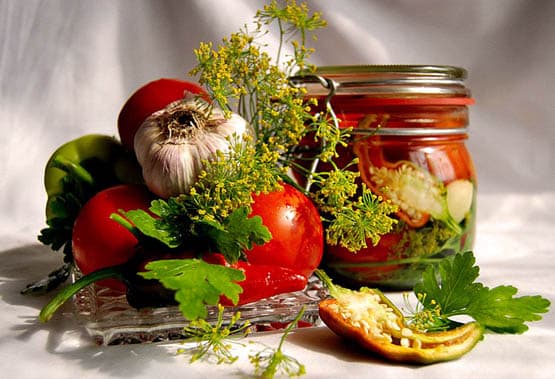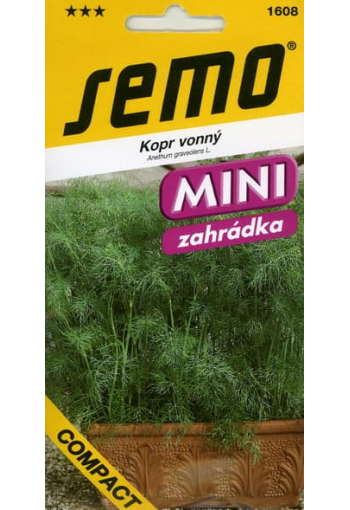Compact branching variety for windowshill growing. Sow repeatidly. Grown for fresh aromatic leaves.
* Since ancient times, dill has been known as a protector of other vegetables from pests. Where dill grows, there is less carrot-, onion-, cabbage flies.
American scientists from the University of Wisconsin have found that fruit flies of Drosophila die if they are adjacent to growing dill.
The main substance acting on harmful insects is the carvone essential oil contained in dill. It has a detrimental effect on these insects. In addition, during flowering, dill attracts entomophagous insects - enemies of harmful insects.
For you and me, dill is of great benefit. In addition to the fact that dill greens supply us with vitamins A, B, C and other biochemically active components, it also has medicinal properties: it raises blood pressure, expanding the lumen of arterial vessels.
Dill is an excellent diuretic, its greens act as a choleretic, laxative, expectorant, soothing agent for insomnia. Every young mother knows about dill water, which babies are given to drink if they are tormented by gases in the intestines. And the miraculous properties of cucumber brine, so revered by our people, belongs to the essential oils of dill, which are in the brine.
Cucumbers without dill are not even salted!
As a remedy for headaches, dill was used by the ancient Egyptians and the ancient Greeks. Dill is a native of the Mediterranean, the cradle of the main cultivated plants grown by mankind.
Dill is unpretentious, hardy, in many summer cottages from year to year every spring it grows by self-sowing, and many summer residents treat this as a common occurrence.
But these self-seeding of dill, as a rule, are early ripening, since in the cold climate dill seeds give early ripening plants.
Such early dill is good for the first greens, for harvesting umbrellas and seeds, and for young potatoes.
Dill umbrellas ripen very early (at the beginning of July), when housewives have not yet started canning cucumbers and tomatoes.
Therefore, for a timely and constant supply of dill and its umbrellas for housewives, by the beginning of the conservation season, it is necessary to sow the necessary varieties of dill on time ourselves ...

Eng.: Dill. Sven.: Dill. Suom.: Tilli. Bot.: Anethum graveolens.
Dill varieties are distinguished by early maturity, not from the emergence of seedlings to harvesting greens - this period depends much more on growing conditions. It averages 30-40 days.
Dill varieties are distinguished by the time of transition to flowering during the long day.
So, the earliest ripening varieties of dill begin to form an umbrella 45-48 days after germination. The period of harvesting greenery lasts 5-7 days. These varieties are very good for growing greens in early spring and for obtaining umbrellas and seeds for spices.
The next group is mid-season varieties. They have a harvesting period of 10-12 days. Varieties of this group are universal, which can be used both for growing herbs and for spices.
And in order to have more fragrant greenery on the site, it is necessary to cultivate late blooming varieties. They are also called "bush varieties". These varieties begin to bloom in the second half of July. Practically from the end of June to the end of July, you will be provided with fragrant herbs.
However, the greens from these varieties of dill must be removed gradually. Cut off the largest leaves: two to four leaves per plant. This will prolong the growing period of fresh greenery. If you repeat the sowing of these varieties again at the end of June, then until the very frost on your site fresh dill will turn green.
Another factor is also important: in August, when the housewives begin the season for rolling the cans for the winter, luxurious umbrellas of late-ripening varieties will ripen just for pickling cucumbers and other preparations.
* Growing dill is not difficult, but you need to know some of its features.
This crop loves loose, fertile soil, and does not thrive on compacted, heavy soils. Dill especially suffers in the lowlands, where water is close to the surface and it reacts very badly to a lack of air. Under such conditions, the plants acquire a characteristic yellow-violet color. After heavy rains, a crust should not be allowed to form around the dill plant - it will prevent air from reaching its roots.
When is the best time to sow dill?
It can be sown at different times, it is only necessary to create conditions for the germination of the seed and, above all, to provide it with a sufficient amount of moisture. Dill can be sown even before winter, in late October - early November. You can sow it in early spring, as soon as the snow melts. In this case, the seed consumption is increased to 10 grams per 1 m2.
With normal sowing in May and summer, you can sow 5 g of seeds per 1 m2, and bush varieties - and 2 g per 1 m2. During winter and early spring sowing, it is good to cover young seedlings with a covering material, which will save the plants from severe frosts.
Dill can be sown on other crops, but it is better to grow it on a separate bed. For this, the seeds are sown in rows. The distance between the rows is 20-25 cm for the convenience of weeding and loosening, and in the row between the plants 2-3 cm and they are gradually thinned out.
Bush varieties are cut to 15-20 cm between plants so that they grow as much greenery as possible.
Do I need to soak dill seeds?
This technique makes it possible to get fast and friendly shoots, but only on condition that soaked seeds are sown into moist soil and do not allow it to dry out before shoots appear. Otherwise, in dry soil, the seeds that have grown will die from a lack of moisture.
Seed soaking can be done at home 2-3 days before planting. The seeds are placed in a linen bag or old tights are used for this (the main thing is that water can easily penetrate through the fabric). A bag of seeds is placed in a container with hot tap water, then, as the water cools, it is changed several times during the day.
After that, the next day, the seeds from the bag are poured onto a damp cloth, dried and sown. Before emergence, crops are watered and weeds removed.
In the first 2-3 weeks, dill grows slowly and is very oppressed by weeds and thickened seedlings. Therefore, the dill garden must be kept clean of weeds and thickened plants must be pulled out for food in time. Dill can be grown outdoors, but if you find a place for it in a plastic greenhouse, dill will give you earlier and more lush greenery.











